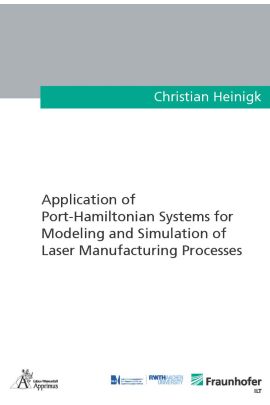Laser manufacturing processes are complex and multi-physical. Modeling such a process requires a subdivision into simpler tasks which can then be simulated and analyzed separately. However, in the end it is paramount to combine the simpler simulations in order to analyze the actual process. Often, this combination is non-trivial, especially when heterogeneous modeling and simulation techniques are employed. Hence, unifying approaches which simplify the development and analysis of such co-simulations are of interest. One approach that gained a lot of momentum in the past years is called port-Hamiltonian systems.
In this monograph, the author combines the port-Hamiltonian systems modeling heat conduction and elasto-dynamics with a plastic material constitutive law. Hereby, the models are derived from first principles. Additionally, the models are scaled and reported in their dimensionless form. The discretization in space is performed using a mixed Finite Element Method and the Crank-Nicolson scheme is implemented to discretize the time domain. In addition to the Crank-Nicolson scheme, three explicit time integration methods are used to discretize the elasto-dynamics equations in time. Subsequently, the sub-simulations are validated and analyzed in numerical experiments. Finally, the combined model is applied to simulate thermally-induced deformations of a cubic metallic solid heated by a laser.
The accuracy of the sub-simulations match the reported precision of the original authors. The slightly different implementation of the plastic material model needs less plastic iterations to reach the same accuracy published in the benchmark. The explicit time integration schemes require at least three times more iterations compared to the Crank-Nicolson and run up to ten times longer. The co-simulation can simulate thermally-induced deformations in a metallic solid due to a laser to satisfactory precision. Additionally, the simulation shows the importance to choose the right plastic behavior as the resulting stresses and deformation deviate up to 20 percent. It remains to be shown how well the co-simulation predicts experiments.
| Autor | Heinigk, Christian |
|---|---|
| Gewicht | 0.326 kg |
| Erscheinungsdatum | 07.10.2024 |
Eigene Bewertung schreiben
Fraunhofer-Institut für Lasertechnik (ILT)
Application of Port-Hamiltonian Systems for Modeling and Simulation of Laser Manufacturing Processes
ISBN: 978-3-98555-237-5
Lieferzeit: 2-3 Tage
54,00 €
inkl. 7% MwSt.
Kurzbeschreibung
Laser manufacturing processes are complex and multi-physical. Hence, they are complicated to model and simulate. To tame this complexity, the author employs port-Hamiltonian systems as a modeling and simulation technique. This technique allows to focus on small subsystems, which, when combined, model and simulate the entire process. In this monograph, elementary Port-Hamiltonian systems of heat conduction and elasto-dynamcis are derived, validated, and finally combined.
Auf Lager

